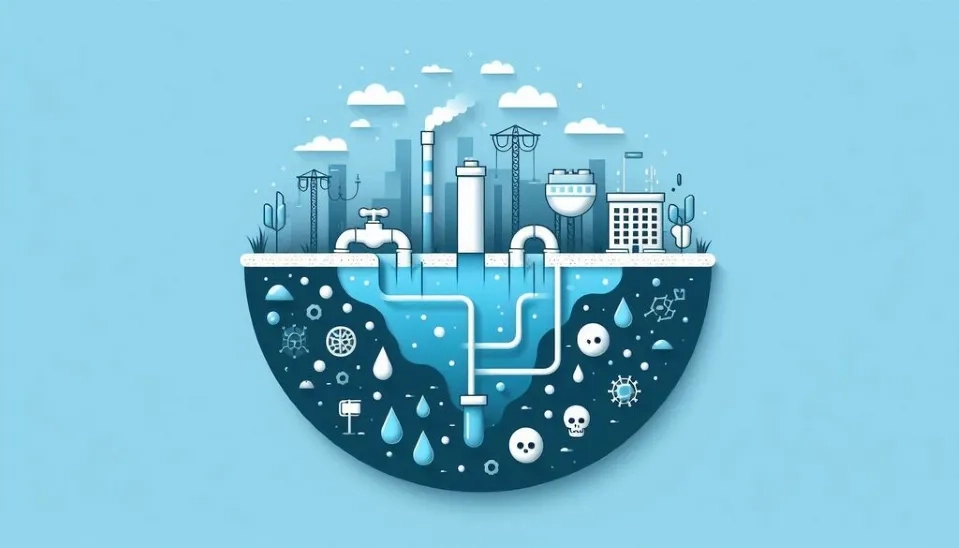
Groundwater is a major source of freshwater for the global population and is used for domestic, agricultural, and industrial uses. Approximately one-third of the global population depends on groundwater for drinking water. More than 2 billion people use groundwater for domestic, drinking, agricultural, and industrial purposes in both developing and industrialized nations worldwide. Approximately 38% of global irrigated areas rely on groundwater resources, which has led to a 10-fold increase in groundwater extraction for agricultural irrigation over the last 50 years (Re, V. 2019). Contaminants, such as toxic metals, hydrocarbons, trace organic contaminants, pesticides, nanoparticles, microplastics, and other emerging contaminants, are a threat to human health, ecological services, and sustainable socio-economic development (Li and Wu, 2019).
Urbanization, agricultural practices, industrial activities, and climate change all pose significant threats to groundwater quality. There are different methods in different sources for classifying groundwater contamination. In this article, we briefly introduce the three main methods of classifying groundwater contamination. These methods are 1) classification based on sources altering the chemical composition of groundwater, 2) classification of groundwater contaminants by type, and 3) classification by mode of contaminant release into groundwater.
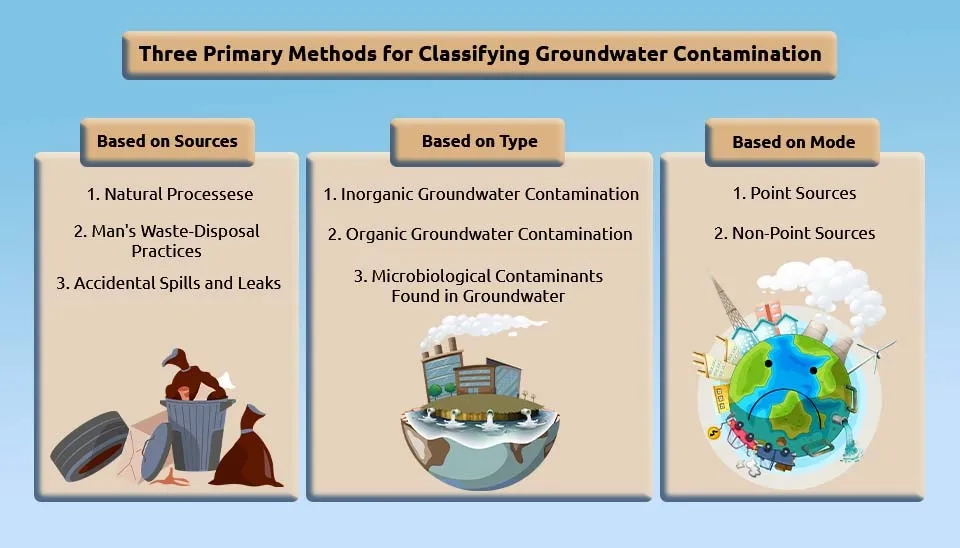
1. Classification Based on Sources Altering the Chemical Composition of Groundwater
There are three main ways to change the chemical composition of groundwater. These ways include 1) Natural processes 2) Man's Waste-Disposal Practices 3) Accidental Spills and Leaks. Below, we will explain these three methods in order.
1.1. Natural Processes
For example, mineralization and evapotranspiration; mineralization can result from leaching, especially in arid areas. Evapotranspiration can further concentrate salts in the remaining water. In the arid southwest and south-central areas of the United States, natural leaching has been identified as the most prevalent source of contamination (Fuhriman and Barton, 1971).
1.2. Man's Waste-Disposal Practices
Groundwater contaminant sources from waste-disposal practices include individual sewage-disposal systems; land disposal of solid wastes; collection, treatment, and disposal of municipal wastewater; industrial and other wastewater impoundments; land spreading of sludge; brine disposal associated with the petroleum industry; disposal of mine wastes; deep-well disposal of liquid wastes; disposal of animal feedlot waste; and disposal of high- and low-level radioactive wastes resulting from a variety of activities. All of these potential sources of contamination are direct effects resulting in natural and synthetic substances entering the groundwater because of human activities (Council, 1984).
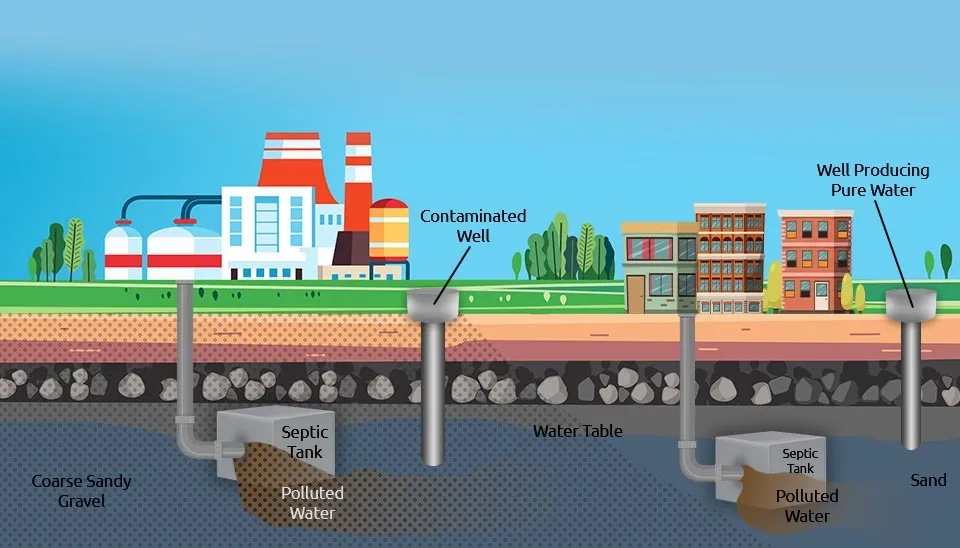
1.3. Accidental Spills and Leaks
This source of groundwater contaminant is also the direct result of human activities but is unrelated to waste-disposal practices. It includes accidental spills and leaks, agricultural activities, mining, highway deicing salts, atmospheric contaminants and acid rain, surface water, improperly planned groundwater development leading to saltwater intrusion, and improper well construction and maintenance (Moore, 1986)
2. Classification of Groundwater Contaminants by Type
The potential sources of groundwater contamination are divided into 3 general categories, which are 1) Inorganic Groundwater Contamination 2) Organic Groundwater Contamination, and 3) Microbiological Contaminants.
Each category contains different contaminations, and we will briefly review each category and its characteristics in the rest of the article.
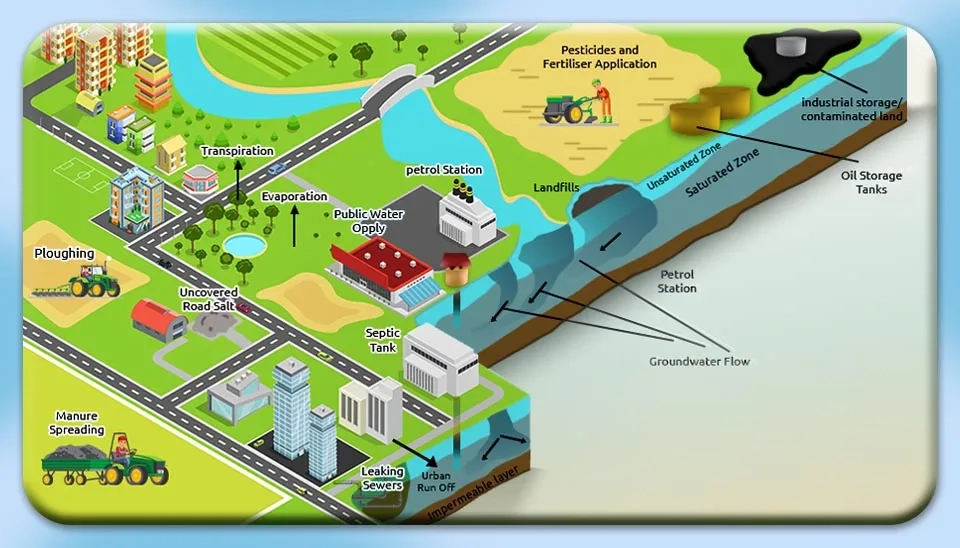
2. 1. Inorganic Groundwater Contamination
The number of inorganic groundwater contamination detections is increasing rapidly, but some of them are
2.1.1. Dissolved Solids
The dissolved solids concentration in water is the sum of all the substances, organic groundwater contamination and inorganic groundwater contamination dissolved in water. This measurement also is referred to as “total dissolved solids,” or TDS. Calcium, magnesium, sodium, potassium, bicarbonate, sulfate, chloride, nitrate, and silica typically make up most of the dissolved solids in water. Combinations of these ions—sodium and chloride, for example—form salts, and salinity is another term commonly used to describe the dissolved solids content of water. It occurs naturally but also enters the environment from man-made sources such as landfill leachate, feedlots, or sewage (USGS, 2019).
2.1.2. Hardness
The simple definition of water hardness is the amount of dissolved calcium and magnesium in the water. Hard water is high in dissolved minerals, largely calcium and magnesium. You may have felt the effects of hard water the last time you washed your hands. Depending on your water's hardness, you may have felt a soap residue on your hands. In hard water, soap reacts with calcium (which is relatively high in hard water) to form "soap scum." When using hard water, more soap or detergent is needed to get things clean, be it your hands, hair, or laundry (USGS, 2018).
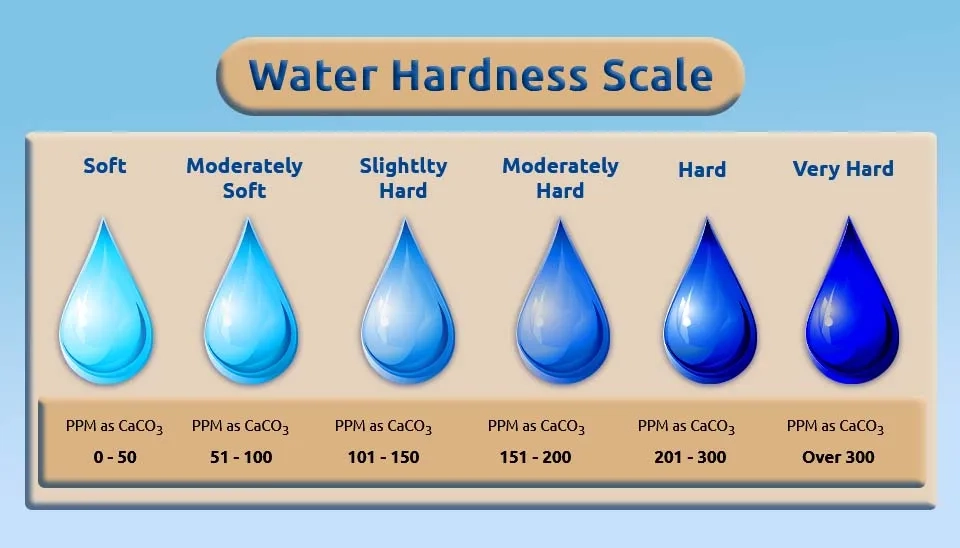
2.1.3. Nitrite (Combined Nitrate/Nitrite) and Nitrate (as Nitrogen)
Nitrogen is inorganic groundwater contamination and nitrogen contaminants, such as nitrate, nitrite, and ammonia nitrogen, are prevalent inorganic groundwater contamination. Nitrate is predominantly from anthropogenic sources, including agriculture (i.e., fertilizers, manure) and domestic wastewater (Hansen et al., 2017; He and Wu, 2019). Groundwater contaminant nitrate has been widely reported from regions all over the world. Total Dissolved Solids (TDS), which refers to the total amount of inorganic and organic ligands in water, also may be elevated in groundwater. These contaminants are usually of natural origin, but human activities also can elevate levels in groundwater (Li et al., 2012).
2.1.4. Sulfate
Elevated concentrations may result from saltwater intrusion, mineral dissolution, and domestic or industrial waste (Miao, 2012).
2.1.5. Heavy Metals
Heavy metals are chemical elements widely detected in groundwater, including metals such as zinc (Zn), lead (Pb), mercury (Hg), chromium (Cr), cadmium (Cd), and metalloids, such as selenium (Se) and arsenic (As). Exposures at high concentrations can lead to severe poisoning, although some of these elements are essential micronutrients at lower doses (Hashim et al., 2011).
2.2. Organic Groundwater Contamination
Organic Groundwater contaminations have been widely detected in drinking water, and many of these compounds are regarded as human carcinogens or endocrine-disrupting chemicals. In groundwater, more than 200 organic contaminants have been detected, and this number is still increasing. Some organic contaminants are biodegradable, while some are persistent (Li et al., 2012).
2.2.1. The Biodegradable Organic Groundwater Contaminations
The biodegradable organic contaminants originate mainly from domestic sewage and industrial wastewater. Many of these organic substances are naturally produced from carbohydrates, proteins, fats, and oils and can be transformed into stable inorganic substances by microorganisms. They have no direct toxic effects on living beings but can reduce the dissolved oxygen levels in groundwater. Common organic contaminants include hydrocarbons, halogenated compounds, plasticizers, pesticides, pharmaceuticals, personal care products, and natural estrogens, among others (Meffe and Bustamante, 2014).
2.2.2. The Persistent Organic Groundwater Contaminations
Many of the halogenated compounds (e.g., chlorinated, brominated, fluorinated) are stable in the environment and can be accumulated and enriched in organisms, causing harmful effects in organisms from higher trophic levels, including humans (Gwenzi and Chaukura 2018). The persistent organic groundwater contaminants are mainly compounds used for agriculture, industrial processes, and the protection of human health. Because these compounds degrade very slowly or even not at all, they may permanently threaten the quality of groundwater for drinking purposes (Li et al., 2012).
2.3. Microbiological Contaminants Found in Groundwater
Coliform and Bacteria: Biological contaminants include algae and microbial organisms, such as bacteria, viruses, and protozoa. For microbial contaminants, more than 400 kinds of bacteria have been identified in human and animal feces, and more than 100 kinds of viruses have been recognized. Some of these microbial organisms originate from natural sources, but some include microscopic organisms that coexist with natural algal species and compete for available resources (Flemming and Wuertz 2019). Drinking water contaminated by microbial contaminants can result in many human diseases, including serious diarrheal diseases, such as typhoid and cholera.
Algal contamination is widespread in surface waters, such as lakes and reservoirs, due to eutrophication, but algae are rarely found at high biomass in groundwater (Li et al., 2012).
Various microbes were identified in groundwater and surface water. Waterborne pathogen contamination and related diseases, namely malaria, dengue hemorrhagic fever, yellow fever, and West Nile fever (WHO, 2006), are major concerns throughout the world.
3. Classification by Mode of Contaminant Release into Groundwater
Groundwater contamination sources can not only be categorized by their potential source of contaminants but are also divided into two categories according to the release sources of groundwater contamination. The two types of release sources of groundwater contamination are 1) point sources and 2) non-point sources.
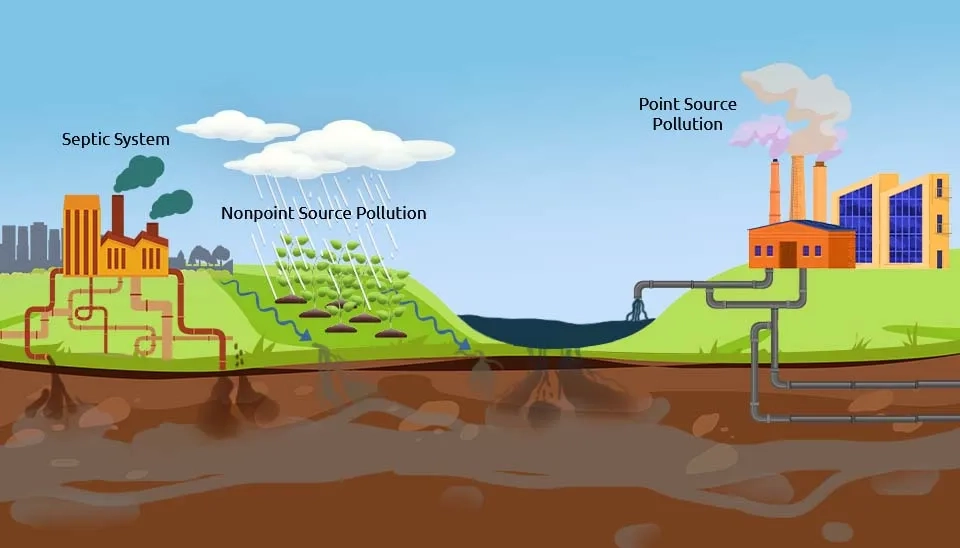
3.1. Point Sources
Point sources are a type of release source of groundwater contamination that is stationary and localized in relatively small areas. They are unconnected or discrete sources that cover only a tiny fraction of the land area of most aquifers. Point sources include landfills, waste dumps, septic tanks, manure storage, underground gasoline storage tanks (gasoline stations), and industrial facilities (Stefanakis et al., 2015; Singhal & Gupta, 2010).
3.2. Diffuse (Non-Point) Sources
Diffuse sources are release sources of groundwater contamination distributed along relatively large areas that are subject to widespread inputs of a range of contaminants. Examples of diffuse sources include fertilizer and pesticides used in agricultural lands, salt and metal runoff from roads and paved areas, and natural sources such as the dissolution of minerals and rocks and seawater intrusion in aquifers (EPA 2023).
4. Conclusion
The sources of groundwater contaminants are broad and abundant, and every day the number of organic and inorganic elements identified that pollute the underground water is increasing. Identifying these factors and their nature helps us to understand the sources of groundwater pollution and plays a significant role in trying to remove these pollutants to have water that complies with the desired standards for any use. Knowledge of contaminating factors and setting standards for their specific amounts will save many people from diseases and problems caused by the increase of pollutants in drinking water. Also, knowing harmful and non-harmful pollutants for human health will reduce the cost of removing them.